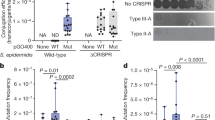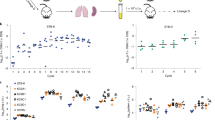Abstract
Bacteriolytic anti-cancer therapies employ attenuated bacterial strains that selectively proliferate within tumors. Clostridium novyi-NT spores represent one of the most promising of these agents, as they generate potent anti-tumor effects in experimental animals. We have determined the 2.55-Mb genomic sequence of C. novyi-NT, identifying a new type of transposition and 139 genes that do not have homologs in other bacteria. The genomic sequence was used to facilitate the detection of transcripts expressed at various stages of the life cycle of this bacterium in vitro as well as in infections of tumors in vivo. Through this analysis, we found that C. novyi-NT spores contained mRNA and that the spore transcripts were distinct from those in vegetative forms of the bacterium.
This is a preview of subscription content, access via your institution
Access options
Subscribe to this journal
Receive 12 print issues and online access
$209.00 per year
only $17.42 per issue
Buy this article
- Purchase on Springer Link
- Instant access to full article PDF
Prices may be subject to local taxes which are calculated during checkout


Similar content being viewed by others
References
Ryan, R.M., Green, J. & Lewis, C.E. Use of bacteria in anti-cancer therapies. Bioessays 28, 84–94 (2006).
Minton, N.P. Clostridia in cancer therapy. Nat. Rev. Microbiol. 1, 237–242 (2003).
Pawelek, J.M., Low, K.B. & Bermudes, D. Bacteria as tumour-targeting vectors. Lancet Oncol. 4, 548–556 (2003).
Barbe, S., Van Mellaert, L. & Anne, J. The use of clostridial spores for cancer treatment. J. Appl. Microbiol. 101, 571–578 (2006).
Theys, J. et al. Tumor-specific gene delivery using genetically engineered bacteria. Curr. Gene Ther. 3, 207–221 (2003).
Jain, R.K. & Forbes, N.S. Can engineered bacteria help control cancer? Proc. Natl. Acad. Sci. USA 98, 14748–14750 (2001).
Cerar, A., Zidar, N. & Vodopivec, B. Colorectal carcinoma in endoscopic biopsies; additional histologic criteria for the diagnosis. Pathol. Res. Pract. 200, 657–662 (2004).
Dang, L.H., Bettegowda, C., Huso, D.L., Kinzler, K.W. & Vogelstein, B. Combination bacteriolytic therapy for the treatment of experimental tumors. Proc. Natl. Acad. Sci. USA 98, 15155–15160 (2001).
Agrawal, N. et al. Bacteriolytic therapy can generate a potent immune response against experimental tumors. Proc. Natl. Acad. Sci. USA 101, 15172–15177 (2004).
Bettegowda, C. et al. Overcoming the hypoxic barrier to radiation therapy with anaerobic bacteria. Proc. Natl. Acad. Sci. USA 100, 15083–15088 (2003).
Diaz, L.A., Jr et al. Pharmacologic and toxicologic evaluation of C. novyi-NT spores. Toxicol. Sci. 88, 562–575 (2005).
Nolling, J. et al. Genome sequence and comparative analysis of the solvent-producing bacterium Clostridium acetobutylicum. J. Bacteriol. 183, 4823–4838 (2001).
Sebaihia, M. et al. The multidrug-resistant human pathogen Clostridium difficile has a highly mobile, mosaic genome. Nat. Genet. 38, 779–786 (2006).
Shimizu, T. et al. Complete genome sequence of Clostridium perfringens, an anaerobic flesh-eater. Proc. Natl. Acad. Sci. USA 99, 996–1001 (2002).
Bruggemann, H. et al. The genome sequence of Clostridium tetani, the causative agent of tetanus disease. Proc. Natl. Acad. Sci. USA 100, 1316–1321 (2003).
Moriya, S., Imai, Y., Hassan, A.K. & Ogasawara, N. Regulation of initiation of Bacillus subtilis chromosome replication. Plasmid 41, 17–29 (1999).
Segall, A.M. & Craig, N.L. New wrinkles and folds in site-specific recombination. Mol. Cell 19, 433–435 (2005).
Songer, J.G. Bacterial phospholipases and their role in virulence. Trends Microbiol. 5, 156–161 (1997).
Titball, R.W., Naylor, C.E. & Basak, A.K. The Clostridium perfringens α-toxin. Anaerobe 5, 51–64 (1999).
Chambon, P., Deutscher, M.P. & Kornberg, A. Biochemical studies of bacterial sporulation and germination. X. Ribosomes and nucleic acids of vegetative cells and spores of Bacillus megaterium. J. Biol. Chem. 243, 5110–5116 (1968).
Jeng, Y.H. & Doi, R.H. Messenger ribonucleic acid of dormant spores of Bacillus subtilis. J. Bacteriol. 119, 514–521 (1974).
Liu, H. et al. Formation and composition of the Bacillus anthracis endospore. J. Bacteriol. 186, 164–178 (2004).
Setlow, P. Spore germination. Curr. Opin. Microbiol. 6, 550–556 (2003).
Fawcett, P., Eichenberger, P., Losick, R. & Youngman, P. The transcriptional profile of early to middle sporulation in Bacillus subtilis. Proc. Natl. Acad. Sci. USA 97, 8063–8068 (2000).
Alsaker, K.V. & Papoutsakis, E.T. Transcriptional program of early sporulation and stationary-phase events in Clostridium acetobutylicum. J. Bacteriol. 187, 7103–7118 (2005).
Wang, S.T. et al. The forespore line of gene expression in Bacillus subtilis. J. Mol. Biol. 358, 16–37 (2006).
Evguenieva-Hackenberg, E. Bacterial ribosomal RNA in pieces. Mol. Microbiol. 57, 318–325 (2005).
Arthur, J.R. The glutathione peroxidases. Cell. Mol. Life Sci. 57, 1825–1835 (2000).
Moore, T.D. & Sparling, P.F. Interruption of the gpxA gene increases the sensitivity of Neisseria meningitidis to paraquat. J. Bacteriol. 178, 4301–4305 (1996).
Weeks, G., Shapiro, M., Burns, R.O. & Wakil, S.J. Control of fatty acid metabolism. I. Induction of the enzymes of fatty acid oxidation in Escherichia coli. J. Bacteriol. 97, 827–836 (1969).
Kunau, W.H., Dommes, V. & Schulz, H. beta-oxidation of fatty acids in mitochondria, peroxisomes, and bacteria: a century of continued progress. Prog. Lipid Res. 34, 267–342 (1995).
Ward, N. & Fraser, C.M. How genomics has affected the concept of microbiology. Curr. Opin. Microbiol. 8, 564–571 (2005).
Coenye, T., Gevers, D., Van de Peer, Y., Vandamme, P. & Swings, J. Towards a prokaryotic genomic taxonomy. FEMS Microbiol. Rev. 29, 147–167 (2005).
Subramanian, G., Mural, R., Hoffman, S.L., Venter, J.C. & Broder, S. Microbial disease in humans: a genomic perspective. Mol. Diagn. 6, 243–252 (2001).
Dang, L.H. et al. Targeting vascular and avascular compartments of tumors with C. novyi-NT and anti-microtubule agents. Cancer Biol. Ther. 3, 326–337 (2004).
Jaeger, K.E., Dijkstra, B.W. & Reetz, M.T. Bacterial biocatalysts: molecular biology, three-dimensional structures, and biotechnological applications of lipases. Annu. Rev. Microbiol. 53, 315–351 (1999).
Forsdahl, K. & Larsen, T.S. Phospholipid degradation in hypoxic/reoxygenated cardiomyocytes in response to phospholipase C from Bacillus cereus. J. Mol. Cell. Cardiol. 27, 893–900 (1995).
Craig, N.L. Target site selection in transposition. Annu. Rev. Biochem. 66, 437–474 (1997).
Cano, R.J. & Borucki, M.K. Revival and identification of bacterial spores in 25- to 40-million-year-old Dominican amber. Science 268, 1060–1064 (1995).
Vreeland, R.H., Rosenzweig, W.D. & Powers, D.W. Isolation of a 250 million-year-old halotolerant bacterium from a primary salt crystal. Nature 407, 897–900 (2000).
Ewing, B., Hillier, L., Wendl, M.C. & Green, P. Base-calling of automated sequencer traces using phred. I. Accuracy assessment. Genome Res. 8, 175–185 (1998).
Ewing, B. & Green, P. Base-calling of automated sequencer traces using phred. II. Error probabilities. Genome Res. 8, 186–194 (1998).
Gordon, D., Abajian, C. & Green, P. Consed: a graphical tool for sequence finishing. Genome Res. 8, 195–202 (1998).
Carraro, D.M. et al. PCR-assisted contig extension: stepwise strategy for bacterial genome closure. Biotechniques 34, 626–628, 630–622 (2003).
Seshadri, R. et al. Genome sequence of the PCE-dechlorinating bacterium Dehalococcoides ethenogenes. Science 307, 105–108 (2005).
El-Deiry, W.S. et al. WAF1, a potential mediator of p53 tumor suppression. Cell 75, 817–825 (1993).
Nuwaysir, E.F. et al. Gene expression analysis using oligonucleotide arrays produced by maskless photolithography. Genome Res. 12, 1749–1755 (2002).
Parmigiani, G., Garrett, E.S., Irizarry, R. & Zeger, S.L. The analysis of gene expression data: methods and software. (Springer, New York, 2003).
Scharpf, R., Iacobuzio-Donahue, C.A., Sneddon, J.B. & Parmigiani, G. When should one subtract background fluorescence in cDNA microarrays? Biostatistics (in the press).
Smyth, G.K. . Limma in Bioinformatics and Computational Biology Solutions Using R and Bioconductor (eds. Gentleman, V., Carey, S., Dudoit, R. & Irizarry, W.H.) 397–420 (Springer, New York, 2005).
Cheong, I. et al. A bacterial protein enhances the release and efficacy of liposomal cancer drugs. Science, in press (2006).
Acknowledgements
The authors thank Peter Setlow for his insightful suggestions about the nature of spore mRNA, Rachel Green for her comments on rRNA fragmentation, Anca Segall for her comments on transposition, and Tanja Davidsen, Michelle Gwinn Giglio and Nikhat Zafar of TIGR for their expert assistance with the genomic bioinformatic analysis. The authors also thank Brent Ewing, Phil Green and David Gordon for kindly providing the Phred/Phrap and Consed software package. The B. subtilis strains were generously provided by Peter Mullany. This work was supported by the Virginia and D.K. Ludwig Fund for Cancer Research, the Commonwealth Foundation, the Miracle Foundation, National Science Foundation grant DMS034211 and National Institutes of Health grant CA062924.
Author information
Authors and Affiliations
Corresponding author
Ethics declarations
Competing interests
The authors declare no competing financial interests.
Supplementary information
Supplementary Fig. 1
rRNA species. (PDF 110 kb)
Supplementary Fig. 2
RT-PCR confirmation of selected microarray data. (PDF 143 kb)
Supplementary Fig. 3
Transcript abundance in denuded spores. (PDF 134 kb)
Supplementary Table 1
Integrated database of C. novyi-NT genome and transcriptomes. (XLS 1009 kb)
Supplementary Table 2
Coding sequences related to mobile elements. (XLS 38 kb)
Supplementary Table 3
Hypothetical CDS unique to C. novyi-NT. (PDF 54 kb)
Supplementary Table 4
Functional classification of C. novyi-NT genes. (PDF 75 kb)
Supplementary Table 5
Other bacteria harboring homologs of the C. novyi-NT transposase. (PDF 82 kb)
Supplementary Table 6
Functional classification of C. novyi-NT genes expressed in specific growth phases. (PDF 68 kb)
Supplementary Table 7
Genes expressed preferentially in different growth phases. (XLS 104 kb)
Supplementary Table 8
Fifthy genes with transcripts most abundant in spores. (XLS 328 kb)
Supplementary Table 9
Genes transcribed during the final stages of sporulation. (XLS 214 kb)
Rights and permissions
About this article
Cite this article
Bettegowda, C., Huang, X., Lin, J. et al. The genome and transcriptomes of the anti-tumor agent Clostridium novyi-NT. Nat Biotechnol 24, 1573–1580 (2006). https://doi.org/10.1038/nbt1256
Received:
Accepted:
Published:
Issue Date:
DOI: https://doi.org/10.1038/nbt1256
This article is cited by
-
A design of experiments screen reveals that Clostridium novyi-NT spore germinant sensing is stereoflexible for valine and its analogs
Communications Biology (2023)
-
Novel molecules as the emerging trends in cancer treatment: an update
Medical Oncology (2022)
-
Characterization of Clostridium novyi isolated from a sow in a sudden death case in Korea
BMC Veterinary Research (2020)
-
Genome-wide discovery of structured noncoding RNAs in bacteria
BMC Microbiology (2019)
-
Disruption of a self-amplifying catecholamine loop reduces cytokine release syndrome
Nature (2018)



